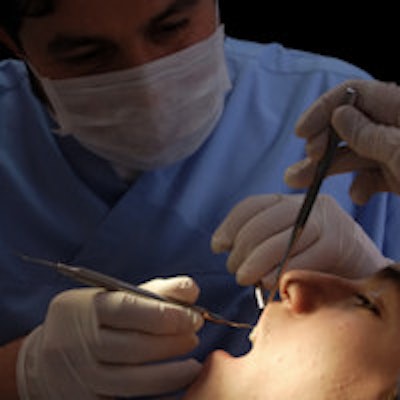
Should dental health now be considered a marker of coronary heart disease? Periodontal disease was associated with cardiovascular risk in a large multicenter study published in the current European Journal of Preventive Cardiology (April 10, 2014).
Periodontal disorders such as tooth loss and gingivitis have been identified as a potential risk marker for cardiovascular disease (CVD) in this study by a team of international researchers. More than 15,000 patients with chronic coronary heart disease (CHD) provided information on their dental health, with results showing that indicators of periodontal disease, such as fewer remaining teeth and gum bleeding, were common in this patient group and associated with numerous cardiovascular and socioeconomic risk factors, according to the European Society of Cardiology.
Conversely, a lower prevalence of tooth loss was associated with lower levels of CVD risk factors, including lower glucose levels, low-density lipoprotein (LDL) cholesterol levels, systolic blood pressure, and waist circumference. Diabetes and smoking also were less prevalent among patients with more teeth, while the likelihood of higher education, alcohol consumption, and work stress was greater.
The study summarized information on self-reported dental health from the Stabilisation of Atherosclerotic Plaque by Initiation of Darapladib Therapy (STABILITY) trial, a clinical trial involving 15,828 participants from 39 countries all with chronic coronary heart disease and at least one additional risk factor for CHD. All participants had a physical examination and blood testing, and completed a lifestyle questionnaire, which included information on dental health. They reported their remaining number of teeth (none, 1-14, 15-20, 21-25, or 26-32 [all]) and frequency of gum bleeding (never/rarely, sometimes, often, or always).
“The evident and consistent relationship between self-reported dental status and cardiovascular risk in this population could point toward periodontal disease being a risk factor for incident coronary heart disease.”
Sweden
Results showed a high overall prevalence of tooth loss: 16% reported were edentulous, and 41% reported having fewer than 15 remaining teeth. Approximately one-quarter of the patients (26%) reported gum bleeding when brushing teeth. However, there was some variation in the results depending on region, country, and ethnic group, with the highest rates of tooth loss and gum bleeding found in Eastern Europe. Overall, almost 70% of participants were current or former smokers.
Statistical analysis showed that increasing prevalence of tooth loss was significantly associated with higher fasting glucose levels, LDL cholesterol levels, systolic blood pressure, and waist circumference. A higher prevalence of gum bleeding was significantly associated with higher LDL cholesterol levels and systolic blood pressure.
The study is the largest of its kind to assess dental disease in coronary patients and demonstrates a heavier burden of CVD risk factors and higher levels of biomarkers among those with more tooth loss and gum bleeding, even after adjusting for confounders, such as age, smoking, diabetes, and education level. The findings suggest common risk factors for dental disease and coronary heart disease, and raise the question of whether self-described dental health can now be considered a useful marker of CVD risk.
The observed regional variations in the prevalence of periodontal disease might partly be explained by regional differences in CV risk factor prevalence, for instance smoking rates. However, the researchers concede that such differences in prevalence indicate a complex relationship in which demographic, genetic, and socioeconomic disparities are likely contributing factors. Both smoking and lower levels of education were strongly associated with periodontal disease, they found.
Lead author Ola Vedin, MD, of the department of medical sciences at the University of Uppsala, in Uppsala, Sweden, said, "The evident and consistent relationship between self-reported dental status and CV risk in this population could point toward periodontal disease being a risk factor for incident CHD." Although poor dental health among chronic coronary patients is linked to a heavier cardiovascular risk burden, it does not prove a causal link between the two conditions, he noted.
"It is still a matter of debate whether periodontal disease is an independent risk factor for coronary heart disease. Some studies point to a moderate association while others are contradictory," Dr. Vedin said. "Our findings show an association between self-reported periodontal disease and several cardiovascular risk factors and as such lend support to a possible association between the conditions." However, he did not go so far as advocating rigorous dental hygiene measures as a strategy to reduce cardiovascular risk.
Age and smoking are well-known risk factors common to both periodontal and cardiovascular disease, with established biological explanations.
The findings also support the notion that periodontal disease and socioeconomic status are closely related, Dr. Vedin said.
He and his colleagues were "astonished" by the high prevalence of severe tooth loss seen overall in the study, but "puzzled" by the marked differences in dental prevalence between countries, even within the same geographical region.



















